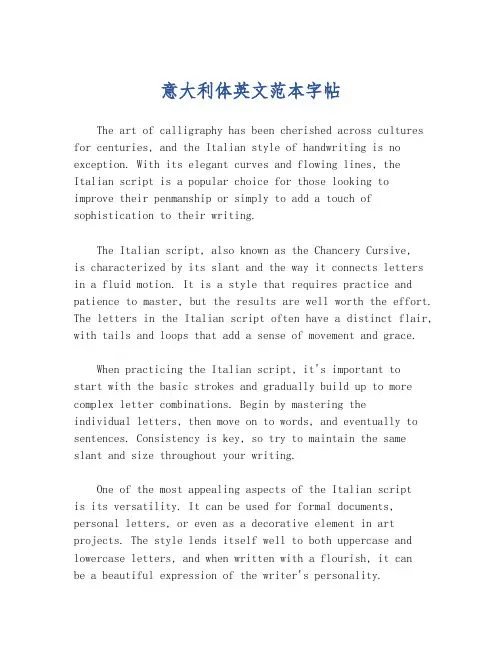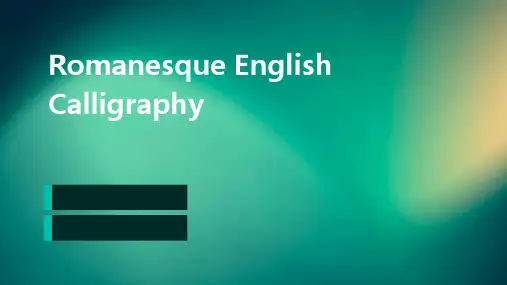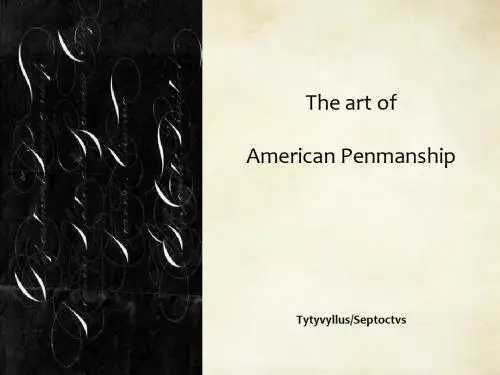罗马体英语书法PPT
- 格式:ppt
- 大小:1.03 MB
- 文档页数:27


意大利花体英文书法Italian calligraphy is a unique and captivating art form that has captivated the hearts and minds of artists and enthusiasts alike for centuries. Originating in the Italian Renaissance, this elegant script has evolved over time to become a symbol of sophistication and timeless beauty. At its core, Italian calligraphy is a harmonious blend of form and function, where each stroke of the pen is imbued with a sense of grace and elegance.The origins of Italian calligraphy can be traced back to the 15th century, a time of great artistic and cultural renaissance in Italy. During this period, the country was home to a flourishing community of scribes, illuminators, and calligraphers who dedicated themselves to the art of beautiful handwriting. These skilled artisans drew inspiration from the classical Roman scripts, as well as the ornate Byzantine styles, to create a distinctive calligraphic style that would become known as the "Italic" or "Chancery" hand.One of the key features of Italian calligraphy is its emphasis on the cursive flow of the letters. Unlike the more rigid and formal Gothicscripts that were prevalent in Northern Europe, the Italic hand is characterized by a graceful, slanted appearance and a sense of fluidity. The letters are connected by smooth, flowing strokes, creating a seamless and harmonious overall appearance. This style of writing was not only aesthetically pleasing but also highly practical, as it allowed for faster and more efficient penmanship.Another hallmark of Italian calligraphy is its attention to detail and precision. The calligraphers of the Renaissance era were masters of their craft, and they took great pride in the execution of each individual letter. The strokes were meticulously crafted, with a consistent weight and rhythm that gave the script a sense of balance and harmony. The use of contrast between thick and thin lines, as well as the careful placement of serifs and other decorative elements, added to the overall elegance and sophistication of the Italic hand.One of the most renowned practitioners of Italian calligraphy was the legendary scribe and calligrapher Ludovico degli Arrighi, also known as "Vicentino." Born in the late 15th century, Arrighi was renowned for his exceptional skill and artistry, and his work is considered among the finest examples of the Italic script. His treatise on calligraphy, "La Operina," published in 1522, became a seminal work that influenced generations of calligraphers and scribes.Arrighi's influence can be seen in the work of many other Italiancalligraphers who followed in his footsteps. From the ornate and highly decorative scripts of the Baroque era to the more minimalist and refined styles of the neoclassical period, the Italic hand has remained a constant source of inspiration and admiration for artists and enthusiasts alike.Today, the art of Italian calligraphy continues to captivate and inspire. Modern calligraphers have embraced the timeless elegance of the Italic script, incorporating it into a wide range of applications, from fine art to commercial design. The use of Italian calligraphy in wedding invitations, greeting cards, and other stationery items has become increasingly popular, as people seek to add a touch of sophistication and timeless beauty to their personal and professional communications.Beyond its practical applications, Italian calligraphy has also found a home in the world of fine art. Calligraphers have elevated the Italic script to new heights, using it as a medium for self-expression and creative exploration. The interplay of light and shadow, the fluidity of the strokes, and the overall aesthetic appeal of the Italic hand have all contributed to its enduring popularity among artists and art enthusiasts.One of the most remarkable aspects of Italian calligraphy is its ability to transcend time and culture. While the Italic script has its rootsfirmly planted in the Italian Renaissance, it has since become a global phenomenon, with calligraphers and enthusiasts from around the world embracing its timeless elegance and beauty. From the United States to Japan, the art of Italian calligraphy continues to captivate and inspire, serving as a testament to the enduring power of the written word and the human desire for artistic expression.In conclusion, Italian calligraphy is a truly remarkable art form that has stood the test of time. From its origins in the Italian Renaissance to its continued influence in the modern world, this elegant script has captivated the hearts and minds of artists, enthusiasts, and everyday individuals alike. Whether used for practical purposes or as a medium for creative expression, the Italic hand remains a symbol of sophistication, beauty, and the enduring power of the written word.。




意大利体英文范本字帖The art of calligraphy has been cherished across cultures for centuries, and the Italian style of handwriting is no exception. With its elegant curves and flowing lines, the Italian script is a popular choice for those looking to improve their penmanship or simply to add a touch of sophistication to their writing.The Italian script, also known as the Chancery Cursive,is characterized by its slant and the way it connects letters in a fluid motion. It is a style that requires practice and patience to master, but the results are well worth the effort. The letters in the Italian script often have a distinct flair, with tails and loops that add a sense of movement and grace.When practicing the Italian script, it's important tostart with the basic strokes and gradually build up to more complex letter combinations. Begin by mastering theindividual letters, then move on to words, and eventually to sentences. Consistency is key, so try to maintain the same slant and size throughout your writing.One of the most appealing aspects of the Italian scriptis its versatility. It can be used for formal documents, personal letters, or even as a decorative element in art projects. The style lends itself well to both uppercase and lowercase letters, and when written with a flourish, it canbe a beautiful expression of the writer's personality.For those new to the Italian script, there are many resources available to help guide your learning process. Calligraphy books, online tutorials, and even app-based learning tools can provide step-by-step instructions and examples to follow. Practice is essential, so don't be discouraged if your writing doesn't look perfect right away.In conclusion, the Italian script is a timeless andelegant form of handwriting that can enhance any written work. With dedication and practice, anyone can learn to write inthis beautiful style and add a touch of class to their correspondence.。





英文书法【Copperplate】第一部分——简介、准备及小写整理:新浪微博@香菜不追爱英文书法简介英文书法顾名思义就是对英文的书写艺术创作,可能很多人不太了解英文书法,其实生活当中处处都有英文书法的影子~像中国的书法一样英文书法也有很多字体,下面就来介绍几种最常见的的字体~【copperplate】(中译为铜版体或铜版印刷)copperplate的特点就是粗细变化非常明显,飘逸灵动,典雅高贵【gothic】(中译为哥特体)gothic是古代教会等机构用来抄写的一种艺术字型,是相当华丽的书写和印刷风格,多见于中世纪时的神学文献。
竖线较粗,且多有装饰性很强的缀线,但是相当不容易辨认。
现多作为报纸标题,起装饰作用。
gothic之中也有很多的分类:【gothic】之【Old English】【gothic】之【German Text】【gothic】之【Square Hands】【Italic】(中译为意大利体)Italic起源于文艺复兴早期并沿用至今日,简单又不失美感如一条绸带飘然纸上。
【Roman】(中译为罗马体)罗马体在它慢长的发展史中渐渐成为世界的标准字母体系,因为它的标准,美丽、灵活性。
它无论在什么情况下,用什么大小都容易去读写。
上面我们介绍了几种常见的字体,那么他们是怎么写出来的呢这就是我们接下来要学的东西了。
但是因为小雨和Carol都是高中生的说。
所以只有在暑假期间能发节目。
于是我们只能教【copperplate】和【gothic】的基础知识,Carol负责【copperplate】部分;我负责【gothic】部分。
大家可以根据自己的喜好选一种来练习也可以两种都学~把写法告诉大家了,最重要的还是自身的练习哦~只有多练多写才会写出那么美美的字呢~所以开始教写法的时候我们会留练习作业,大家把自己的练习图片拍下来输到电脑里,再通过写日志版面的图片→本地上传,上传图片之后右键点击图片→图片属性→图片地址,把地址复制到回复框里就OK啦~目前小雨只想到这个办法。